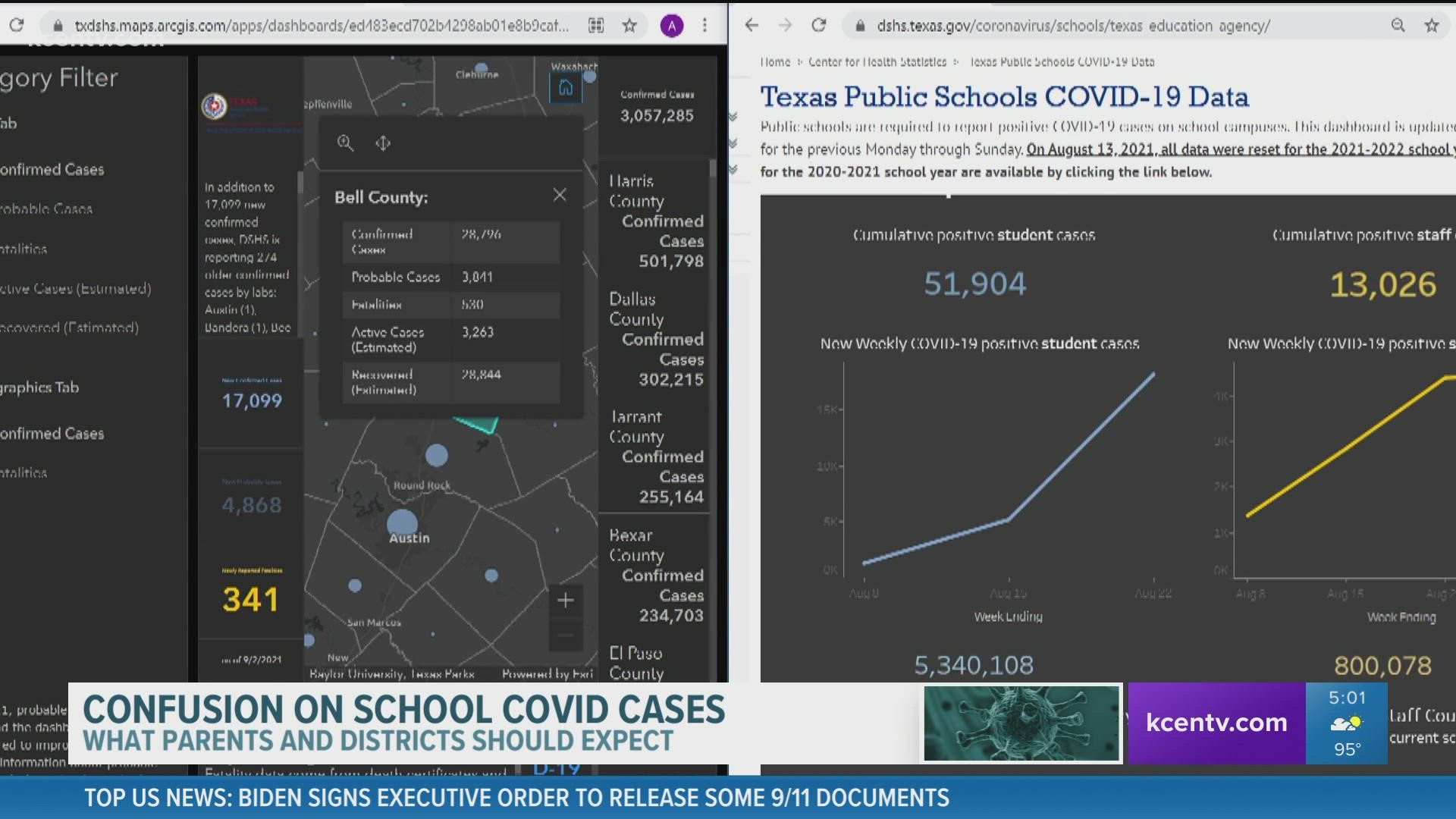TEMPLE, Texas — Central Texas school districts are reporting COVID-19 cases three different way: School districts report numbers to the county health district, the Texas Education Agency (TEA) and on their own dashboard if they choose to have one.
Unfortunately, the rules for exactly how school districts should be reporting the information to agencies. Where that information goes can be confusing or even missing. That's why 6 News spent two days trying to straighten it all out.
The main issue we found: TEA and the Texas Department of State Health Services are not using the same language to describe COVID-19 testing.
Defining terms
Not all COVID-19 tests are equally reliable. Reverse transcription polymerase chain reaction tests (PCR tests) are most often recommended for confirming a COVID-19 case. Rapid antigen tests, which detect the presence of a specific viral antigen, can take minutes instead of days, but are less sensitive in detecting COVID-19. The CDC often recommends following up with a PCR test for confirmation.
For this reason, the Texas Department of State Health Services classifies PCR lab test results as "confirmed cases" and antigen test results as "probable cases" on the state dashboard.
TEA requirements use neither of these terms.
The reporting dilemma
So what is a school district required to report?
TEA requirements state: "If an individual who has been in a school is test-confirmed to have COVID-19, the school must notify its local health department, in accordance with applicable federal, state and local laws and regulations..."
The TEA does not, in its guidance, specify exactly what "test-confirmed" means.
Temple ISD told 6 News the state had previously only required positive PCR tests to be reported, which would make sense given those tests are used to confirm results.
"That's exactly how we did it last year. Not just us, but every school district," TISD Superintendent Bobby Ott told 6 News Friday.
But when 6 News finally got clarification from the TEA Thursday afternoon, it turns out the TEA is referring to both PCR and antigen test results.
TEA spokesman Jake Kobersky told 6 News in an email, "Test-confirmed positive cases, including those identified by rapid tests, should be reported."
Kobersky further clarified on the phone that the TEA wants all tested cases grouped in the same numerical value. One number. Not multiple numbers.
But while the TEA wants all COVID-19 test results reported in one data field, health departments are asking for the DSHS format.
Health Districts use the same differentiation of "confirmed cases" and "probable cases" as DSHS, according to Bell County Public Health District Chief Epidemiologist Costa Claver.
"The state, and CDC, agree that these are two different things," Claver told 6 News Friday. "Both of them can be positive but one can be positive confirmed and the other positive probable...The state wants us to report those separately."
Claver also made clear the Bell County Health District will not count any rapid COVID-19 test completed entirely at home and only accepts tests from labs or administered by health care professionals.
This leaves school districts reporting case numbers to the TEA one way and to the health district another. At the same time, both of those agencies report data to the Texas Department of State Health Services (DSHS), which aggregates the data.
That left Temple ISD concerned that the separate reports could lead to inaccurate case totals in DSHS data.
"The health departments records at the county level are accurate," Ott said. "But when it goes to the state departments dashboard from TEA, there is a high probability that it is not going to be accurate, because TEA is collecting data inconsistent with the reporting dashboard metrics at the state department level...there is no way to distinguish between probable and confirmed positive."
After contacting DSHS again, however, 6 News found out this will not be an issue. While DSHS does receive two different report formats from the TEA and from Health districts, it puts them in two completely different dashboards.
DSHS has a COVID-19 dashboard for the whole state. This dashboard includes probable and confirmed cases, which you got from local health districts and other reporting agencies.
DSHS also has a page with Texas Public School COVID-19 data. This dashboard includes data from school districts themselves, which is collected by the TEA and does not differentiate between "probable" and "confirmed" cases.
DSHS spokesman Chris Van Deusen told 6 News Friday via email, "Those two data sets are collected by different people in different ways for different purposes and may represent different periods, so you can’t directly compare them."
Local school dashboards
Finally, if school districts are following the rules and have two sets of data going to two different agencies, what do they put on their own dashboard?
It turns out, the TEA has no specific requirements for what a school district puts on its local dashboard or what it leaves out.
Up to this point, Temple ISD was only reporting "confirmed cases," or cases confirmed with a PCR lab test result. Starting next week, the school district will also list "probable cases" from rapid tests separately for the sake of clarity.
There are currently no rules preventing other school districts from including only PCR lab confirmed cases, or from including all kinds of test results including those from at-home tests. For this reason, parents should be wary of comparing the results of one ISD's dashboard to that of another.

